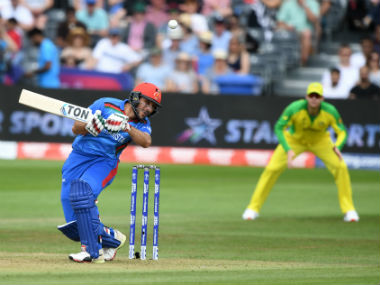The Afghanistan innings started and ended with stumps being sprawled across the turf. What transpired in between the first and last dismissal was a well-disguised short ball bombardment from the Australian pace battery that led to Afghanistan being skittled for a paltry 207. Three Afghanistan batsmen had perished to the sharp lifters and on a better day, it could have been a lot worse. [caption id=“attachment_6741851” align=“alignleft” width=“380”] Australia’s bouncer barrage had Afghanistan batsmen ducking for cover. AFP[/caption] The bouncer assault was scripted meticulously on all accounts. Initially, for the first five overs, Mitchell Starc, and Pat Cummins pitched the ball up, trying to gain some swing, but once the Kookaburra had lost its shine, it was up to the quick men to bend their back and intimidate the opposition. Cummins was the catalyst. He stormed in and repeatedly hurled the ball with great force into 22-yard turf. The speedometer showed the ball thudding into Alex Carey’s gloves at over 140km/h. It was a docile and slow pitch, but such was the quality of Cummins that he made life miserable for experienced players such as Hazratullah Zazai, Rahmat Shah and Hashmatullah Shahidi. Starc had disturbed the timber with the full ball, so the sudden change of tactics had also caught the Afghanistan batsmen napping. Their footwork was unsettled and their minds scrambled. The Australian quick bowlers had already won the mental battle and the onus had now shifted to making sure the short ball theory didn’t get too predictable. Cummins was the enforcer and Nathan Coulter-Nile, along with Marcus Stoinis, followed suit. Afghanistan top order has been brought up on the low decks of the subcontinent and had rarely confronted pace bowling of the calibre of Starc, Cummins, and Coulter-Nile. The three fast bowlers along with Stoinis had made it a personal mission to demolish the opposition with the bouncer barrage. Each over after the fifth had at least one bouncer. Not all the deliveries were accurate, some were misdirected and at times Gulbadin Naib and Najibullah Zadran made the tactic look rather conventional. Stoinis and Coulter-Nile were dispatched for a handful of boundaries as Najibullah fought his way to a fighting half-century. Stoinis looked susceptible at times, but the bulky all-round stuck to the game plan. Aaron Finch backed him to mix his deliveries and then slip in the quick bouncer. A few sailed over the batsmen, but Stoinis persisted. Stoinis even risked giving away extras, but his perseverance was justified with two crucial wickets of the well-set Gulbadin and Najibullah. The pair had added 83 runs, but in a space of five balls, both had succumbed to the adventurous hoick against the short ball. At the end of the innings, eight of the 24 boundaries Afghanistan hit came against the back of the length delivery. Attacking the short ball had yielded runs, but at the same time, the venom on the ball led to their downfall. At times, it looked reckless, but a lot of credit had to be given to the Australian plan of unsettling the Afghan batsmen with a series of bouncers. Close to 25 percent of the balls Australia bowled pitched eight meters away from the batsmen. Nearly every short ball attempted was on the off-stump line, meaning the Afghanistan batsmen had to hook or sway. Such was the exemplary lines that apart from one instance, none of the batsmen were given the width to flay or uppercut the ball through the off-side. It was clear that Australia had thought long and hard about how to dismantle the Afghanistan batting. The fear instilled by the fast men also led to Afghanistan batsmen taking risks against Adam Zampa. The crafty leg-spinner benefitted by taking three wickets from his eight overs. Asked at the post-match press conference about Australia’s strategy, Zampa said, “We knew a lot of them their guys are used to playing on the slow decks so it was going to be a challenge for them to face the short ball.” At the end of the day, the Afghanistan batsmen had a few bruises and also some mental scars. Australia, meanwhile, will be confident that they have the bowlers that can utilise the short ball to great effect during the tournament. Coulter-Nile also shed insight into the short bowling plan after the game and also warned the West Indies to expect the same tactic in the next match. “You have to give it to the Windies or else they’ll get on to the front foot and you’ll go everywhere. We will give it to every team. The pitches are so flat and the grounds are so small, you have to,” Coulter-Nile told reporters at end of the match. For all the latest news, opinions and analysis from ICC Cricket World Cup 2019, click here
At the end of the day, the Afghanistan batsmen had a few bruises and also some mental scars. Australia, meanwhile, will be confident that they have the bowlers that can utilise the short ball to great effect during the tournament.
Advertisement
End of Article


)

)
)
)
)
)
)
)
)



